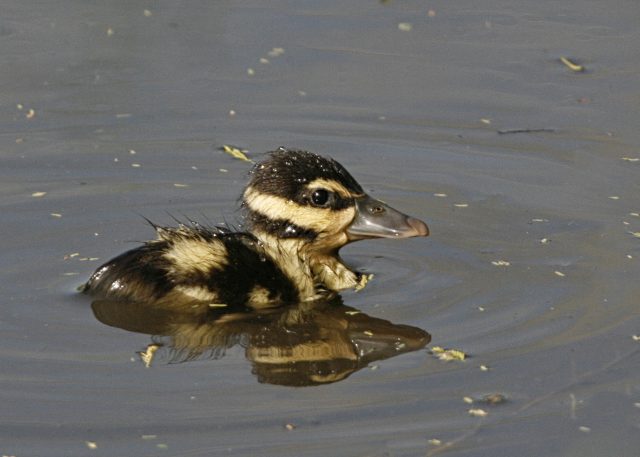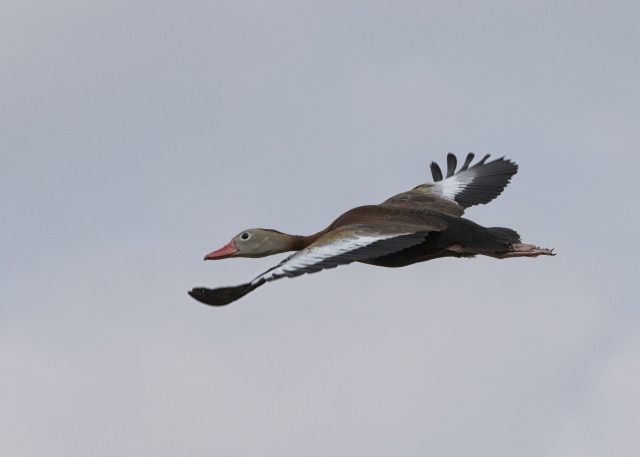05/26/2017 – It Looks Like a Duck…But Is It a Duck? (Karen Benson)

All baby animals are cute, but ducklings are especially so. This Black-bellied Whistling-Duck baby was born in a tree cavity. Shortly after hatching, he and his siblings jumped to the ground (or water) and began following their parents around. Robert Benson Photo.
Everybody knows a duck when he or she sees one, right? I mean, if it looks like a duck, walks like a duck, and quacks like a duck, then it is a duck!
Whoa! Hold on! Right here in Bee County we have a species of duck that doesn’t quite look like a duck or act like a duck. And it doesn’t quack either. It whistles!
So is it a duck? Well, yes. Sort of. What is this weird duck? It is the Black-bellied Whistling-Duck. Whistling-Ducks are common residents here and throughout South Texas.
You have probably seen them flying over, especially in the morning or evening. Even in flight they don’t quite look like ducks. They appear black with broad white wing patches visible on the downbeat of the wings. They look somewhat humpbacked and their legs stick out beyond their tails. Their necks are long, almost goose-like. Their bills and feet are an arresting shade of hot pink. And, then there is that odd wheezy whistle they make. It sounds like “pe-che-CHEE-ne” and they often give it in flight.
Black-bellied Whistling-Ducks are special. The genus consists of just eight species worldwide. Only two of these are found in the Americas. The rest of the species in the genus Dendrocygna inhabit far off places like the East Indies, Australia and Africa.

Black-bellied Whistling-Ducks have a distinct hump-backed look in flight. A broad white patch is visible on each wing on the downbeat. Their long pink legs stick out beyond their tails. However, their most distinct characteristic is their wheezy whistling call. Robert Benson Photo.
The genus name, Dendrocygna, means “tree-swan.” So Dendrocygna autumnalis is the “autumn tree-swan”. Its close cousin, the Fulvous Whistling-Duck (Dendrocygna bicolor), the “two-color tree-swan, is a warm brown-and-black duck more commonly found in treeless areas, especially rice fields.”
For many years, the official common name for D. autumnalis was the Black-bellied Tree Duck (not Tree-Swan as you might expect.) You are probably wondering what these ducks have to do with trees, anyway. In very unducklike fashion, these long-legged birds perch in trees! Their webbed duck feet actually can wrap partially around a limb. Also, many “tree ducks” nest in tree cavities. Their preferred nest site is a hollow in a tree about eight feet up from the ground near water. They will happily nest in nest boxes set up on poles near a pond, and even occasionally will nest on the ground, but tree cavities are definitely preferred.
The breeding behavior of Black-bellied Whistling-Ducks is unusual and admirable. First, like swans, the pair mates for life. This is why during the breeding season you generally see two ducks flying over the treetops together. Second, the male (called a drake) incubates the eggs with only a little help from the female. This behavior is almost unknown among the waterfowl; indeed it is uncommon among all birds.
Shortly after hatching, the ducklings make a leap for the ground. Water or mud makes for a softer landing for the little guys. The broods are big, sometimes 16 ducklings, and every one of them is as cute as a button! The parent birds lead the young ones around, usually in the water, feeding on aquatic vegetation. It is really a picturesque and heart-warming sight.
Prior to the 1960s, Black-bellied Whistling-Ducks were unknown in Texas. As their bright coloring suggests, they are a tropical species. Initially their range included Mexico and extended further south into Central and South America. But two mainly human-based changes in habitat served to jumpstart their advance into South Texas. The first was the construction of the Wesley Seale Dam on the boundary of Jim Wells and San Patricio Counties in 1958. This flooded the Nueces river bottomlands almost to George West. Thousands of live oaks, pecans, mesquites, and other trees were drowned and left standing in shallow water. As holes in the tree trunks enlarged with decay, the “tree ducks” were presented with new nest sites. They were quick to take advantage of them. This new increase in “housing” was accompanied by an increase in food supply. Local farmers and ranchers were planting thousands of acres of corn, sorghum and oats (the second human-based change). Whistling-Ducks were all too happy to glean waste grain from the fields. By 1962 “a fine population of D. autumnalis” was reported on Lake Corpus Christi.
The result of all of this is that we now have another South Texas avian specialty. These beautiful ducks with their coral-colored beaks and legs have brought the look of the tropics to our ponds and lakes. They are a delight to watch as they raise families of charming little ducklings. Let’s enjoy them!
